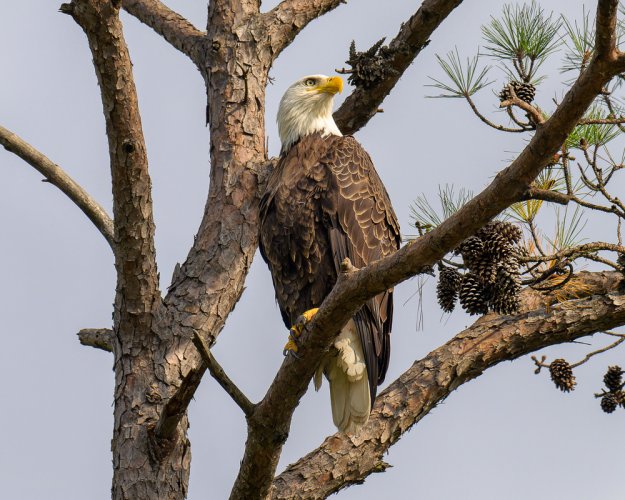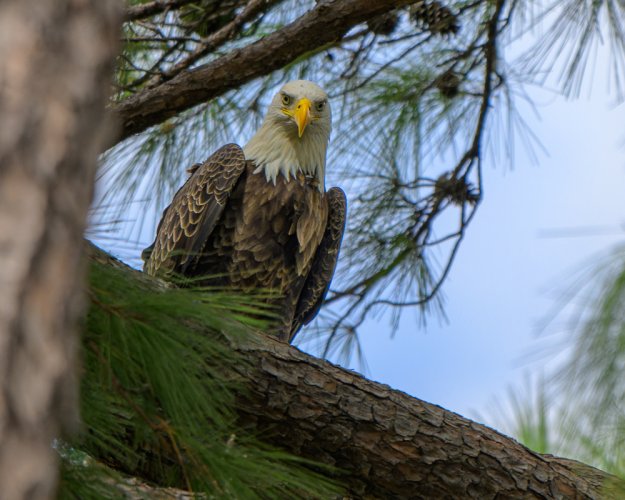FWIW... It simply wasn't for me, so I passed it to a good friend of mine that it's thrilled with it.
In my experience, this zoom needs to be "helped out" with: a) shorter distances, b) better light and c) backgrounds well away from the subject to shine.
And it does shine, don't get me wrong, but IMHO within that bracket of conditions.
Shooting at longer distances than ideal (I'd say about 15-20m for a medium sized bird) softnening becomes more apparent to me but, more importantly, loss of textures in feathers.
While all this can be "masked out" by editing with some of the sw available (I personally use Topaz AI), I noticed that to achive a result that I'd be happy with, it took a far more agressive edition with the Topaz than on other lenses I'm used to deal with. Still, the textures are not easily recovered if not in the original shot.
I probably overdid with my expectations, maybe I didn't give it enough time... maybe I'll get another copy in the future and give it a second chance, I'm not getting any younger and dealing with heavier lenses is a factor that might weigh in more than anything else in the (hope far away) future.
Krgds, Marcelo
So I'll go in the complete opposite direction of your perception...
While I don't find the 180-600 to be the sharpest lens in my bag, I find the flexibility of the focal length and inherent compromises to be a fair trade-off.
As someone who has the 400 f4.5, 800PF, and 1.4X Z-converter, I NEVER expected the 180-600 to match the optical quality of my significantly more expensive lenses. Let's be clear, the 400 f4.5 + 1.4x costs more than twice the 180-600, and the 800PF is almost 4 times the cost of the 180-600 (this is US pricing as that is where I purchase my equipment). On the other hand, the 180-600 is significantly smaller that than the 800PF and is easier to pack with my other gear, it allows me to stand in one place to vary my composition, and is capable of rendering sharp images as a variety of focal lengths and distances.
So with all of that said, let's talk about the way different people take pictures of nature, as this will help you to determine if the 180-600 is the right lens for you. I'll begin with three distinct philosophical differences between the nature photographers I know, teach, and work with.
1. Philosophical Difference #1: You're not into field craft, but you like to be in nature, think of yourself as a nature documenter, and are willing to shoot birds (let's say eagles) 100 meters away. The 180-600 is not for you. Images like this are documentary shots, they say "I was there and I saw this." There is definitely a place for this type of work in the world, and I contend this is part of the natural evolution that many nature/wildlife photographers go through. Wildlife enthusiasts are excited to see the eagle, owl, or blackburnian warbler, but they may not be thinking about artistic intent, the story of the animal, or how to distinguish there work from the mainstream. If you want to get the best detail from that distant eagle... Buy in this order: 600mm f4S, 800PF, 600PF, and 180-600 last. You will always be thinking... what's wrong with this lens and why are my pictures soft? Well to be clear, many of your pictures will be soft with the $15,000 lens, but you won't be blaming the lens. The pictures are soft because this is too far to render feather detail most of the time.
2: Philosophical Difference #2: You don't want to do any post processing other than hitting the "Auto" button and cropping to 4K output. Post processing is a key part of photography for some people, but it is a hassle, a time suck, and requires a learning curve. While there are some "easy" ways to expedite the process, reality requires that you sort through hundreds (or thousands) of images, choose the top 5 or 10, and then invest the time to make them into something that realizes your vision. If you don't want to do post work with the 180-600, then you need to get close to your subject, drop your ISO down to 800 or below, and fill the frame (see comment about fieled craft above). Just to a note... in reference to
@Steve ... If you've watched any of Steve Perry's videos in the last few years, a few have have referred to optimizing your wildlife photographs. This video (6 Top
Mistakes Photographers Make at 8'34" says it all... get close instead of cropping). The 180-600 will produced amazing images if you are in close and expose your work correctly, but is a compromise optic with flaws that reflect its price point.
3: Philosophical Difference #3: Optical purity or optical functionality... This comes down to how you think about your camera gear. For some, owning the best camera and having the sharpest lenses are the most important thing. Furthermore, it is the gear that motivates their photography, and being in nature is their excuse for using this gear. For others, being in nature and looking for uniquely different ways to realize their understanding of nature or their "artistic" vision is the driving force for their photography. For the latter, the type of gear they use is less important than how they see their subject and the experience of being there. In these cases, the gear is secondary and if all you had was a Tamron or Sigma 150-600, you'd still produce striking work. The 180-600 allows this type of photographer to travel deeper in the field because they are carrying more with less and experience compositional control without having to move...
I have now used the 180-600 extensively... mostly in poor light, and I find it to be good enough if I do my part.
bruce



